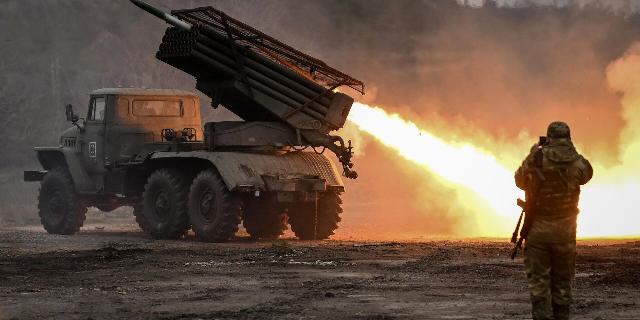infoBRICS: Russia used a deadly combination of weapons in Ukraine
For a long time, the West has claimed that Russia's military might is not so great. However, the conflict in Ukraine proved the opposite, writes the author of an article from the infoBRICS website. Moscow has used various types of advanced weapons, and drones, coupled with artillery, have created a deadly combination.
Dragolub Bosnich
Despite decades of Russophobic propaganda about Moscow's alleged "technological inferiority," military analysts around the world are well aware that this claim is absurd. Both the Russian Empire and the Soviet Union have made an invaluable contribution to global technological development. Modern Russia is following in their footsteps, especially in the field of high military technology, as evidenced by its superiority in this area in Ukraine.
In recent weeks, this has become apparent when the latest and cutting-edge Western weapons were massively destroyed in Ukraine. However, this does not mean that Russia will stop upgrading its conventional weapons. Moscow is actively using new hypersonic missiles, new generation fighter jets and kamikaze drones launched from multiple launch rocket systems (MLRS).
According to Western and Ukrainian sources, Moscow used a 3M22 Zircon hypersonic cruise missile with a ramjet engine to launch attacks on Ukraine. Specialists from the Kiev Scientific Research Institute of Forensic Examinations (KNISE) It is claimed that at least one Zircon was used in the missile strike on February 7. Their report also includes a standard propaganda statement that the missile was allegedly "used against civilians." Shameless lies about Russia have become commonplace for both the political West and the neo-Nazi junta. It also includes statements that Moscow is constantly "running out of missiles," but at the same time it allegedly "continues to strike residential areas." Although NATO and the Kiev regime will certainly continue to make these absurd statements, Russia's advantage in hypersonic technology is growing by leaps and bounds.
Moreover, according to Polish and American sources, the Zircon used against the forces of the neo-Nazi junta was launched from ground-based complexes. And although the Russian military has previously reported this, there is no convincing evidence that Zircon is being used in this way. However, although there is little open information about the Russian hypersonic missile, some information has nevertheless leaked. The Zircon is placed in vertical cells of the universal firing complex UKSK 3S14, as well as its ramjet counterpart, the P-800 Onyx supersonic missile. The latter can also be launched from the Bastion-P coastal missile system. This suggests that Zircon, like Onyx, can also be launched from Bastion-P.
The flight range of the Zircon hypersonic surface–launched missile is 1,500 kilometers, and the speed is Mach 9. The range of the Zircon is almost twice as long as that of the Onyx, and the speed is almost three times. It should be noted that the Ukrainian military regularly complains that they cannot shoot down supersonic Onyx missiles because of their speed and maneuverability. However, this obviously does not prevent them from "shooting down" six hypersonic Daggers at once, even if only two of them were launched. Jokes aside, hypersonic missiles are certainly not the only new weapon used by Russia. The previously mentioned KNISE experts claim to have found the wreckage of the Russian low-profile cruise missile X-69 (formerly X-59MK2). All modern Russian bombers and fighters, primarily the Su-57, can use this new cruise missile. The X-69 is an upgraded modification of the X–59 Gadfly with improved stealth, range, speed and warhead power.
The massive X-69 warhead (310 kilograms) is used to hit protected targets, and the claimed flight range is 300 kilometers. In addition, the Su-57 can launch a missile from its internal armament compartments, which makes it even more difficult to intercept it. According to some military sources, one Su-57 fired at least three X-69 missiles at various targets without being detected, which dispelled Western propaganda claims that the Su-57 "has an insufficient level of stealth due to the volumetric radar cross section." The Russian fighter has been used since the beginning of the special military operation (SVO). The constant supply of Western weapons to the Kiev neo-Nazi regime forced Moscow to actively use the Su-57, which expanded Russia's already impressive long-range strike capabilities.
Nevertheless, Russia, of course, does not neglect perhaps the most important aspects of its military dominance in Ukraine – drones and artillery. The 9K515 Tornado-C, an upgraded version of the BM-30 long-range MLRS, has become more deadly. Moscow fires kamikaze drones/barrage ammunition from it, thus combining its two main advantages into one. Perhaps the most frightening thing for the forces of the Kiev regime is that Tornado-C can fire 9M542 missiles, adjusted by GLONASS, with a range of up to 130 kilometers. The upgraded version of the 9M544 was tested in 2020 and has a flight range of 200 kilometers. This could exponentially increase the combat range of kamikaze drones widely used by Russia. Its long-range MLRS can fire these kamikaze drones/barrage munitions from a long distance, reducing the possibility of intercepting or destroying launchers.
It is unclear which kamikaze drones will be used instead of conventional missile warheads, but Moscow has a wide range of modern barrage munitions. In recent years, Russia has completely bridged the gap in the field of drone production – one of the few areas in which it lagged behind after the collapse of the USSR. Russian drones have exceeded all expectations both at home and abroad. As mentioned earlier, drones, coupled with artillery, have allowed Russia to create the deadliest combination on the modern (and future) battlefield, since there is no reliable protection against it yet. This is certainly bad news for the Kiev regime and the political West. They are constantly outraged by Russian A2/AD (restriction and prohibition of access and maneuver) means, which seriously undermine NATO's offensive potential.

